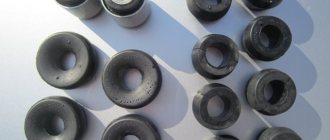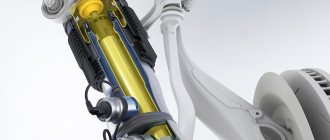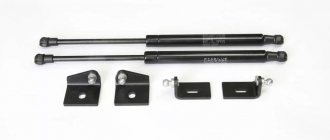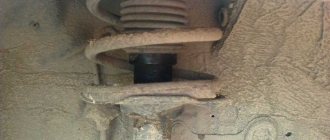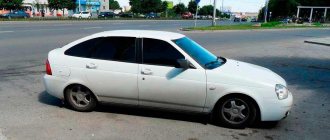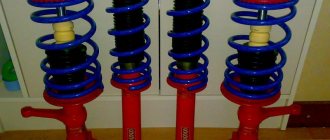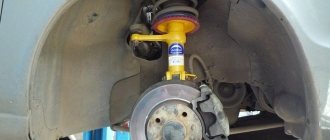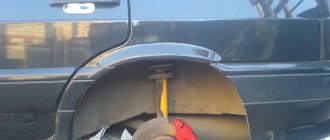The controllability and ease of use of the VAZ 2107 directly depends on the suspension, in which the shock absorber is an important element. Each owner of this car should be able to identify damper faults, independently select and replace it.
- Purpose and design
- What are there
Table: dimensions of the rear original dampers of the “seven”
- Oily
- Gas
- Gas-oil with constant hardness
- Gas-oil with variable hardness
- Video: types of shock absorbers and their differences
- Shock absorber malfunctions
Oil leaks
Video: identifying a faulty damper without removing it from the car
- Video: why the rear shock absorbers pull out
- Which ones to choose
Table: analogues of rear shock absorbers of VAZ 2107
- Video: pumping gas-oil shock absorbers
- Double
Shock absorbers VAZ 2107
Despite the fact that the VAZ “Seven” is presented as a luxury version of the VAZ 2105, the design of the front and rear suspensions is no different from other classic models. This also applies to shock absorbers, which not all owners are satisfied with their performance.
Purpose and design
The main function that shock absorbers perform in a car’s suspension is to dampen vibrations and shocks that affect the body when driving over uneven surfaces. This part ensures reliable contact of the wheels with the road surface and maintains vehicle controllability regardless of the condition of the road surface. Structurally, the shock absorber consists of two elements - a piston and a cylinder. Depending on the type of damping device, chambers with oil and air or oil and gas are located inside the cylinder. The gas or oil medium exerts resistance during the movement of the piston, converting vibrations into thermal energy.
Design of shock absorbers of the front and rear suspensions: 1 - lower eye; 2 — compression valve body; 3 — compression valve discs; 4 — throttle disk of the compression valve; 5 — compression valve spring; 6 — compression valve cage; 7 — compression valve plate; 8 — recoil valve nut; 9 — recoil valve spring; 10 — shock absorber piston; 11 — recoil valve plate; 12 — recoil valve discs; 13 — piston ring; 14 — recoil valve nut washer; 15 — throttle disk of the recoil valve; 16 — bypass valve plate; 17 — bypass valve spring; 18 — restrictive plate; 19 - reservoir; 20 - rod; 21 - cylinder; 22 — casing; 23 — rod guide bushing; 24 — sealing ring of the tank; 25 — rod seal race; 26 — rod seal; 27 — gasket of the rod protective ring; 28 — rod protective ring; 29 — tank nut; 30 — upper shock absorber eye; 31 — nut securing the upper end of the front suspension shock absorber; 32 — spring washer; 33 — shock absorber mounting pad washer; 34 — pillows; 35 — spacer sleeve; 36 — front suspension shock absorber casing; 37 — rod buffer; 38 - rubber-metal hinge
What are there
There are several types of shock absorbers:
- oil;
- gas;
- gas-oil with constant hardness;
- gas-oil with variable hardness.
Each option has its own advantages and disadvantages.
On the VAZ 2107, oil twin-pipe shock absorbers are installed at the front and rear.
Table: dimensions of the rear original dampers of the “seven”
| vendor code | Rod diameter, mm | Case diameter, mm | Body height (excluding stem), mm | Rod stroke, mm |
| 21012915402 | 16 | 42 | 310 | 182 |
Oily
The working medium in oil damping elements is oil. The advantage of such products comes down to a simple and reliable design. This type of damper can operate without problems for several years without affecting the vehicle's performance. The downside is the slow response. The fact is that when driving at high speeds, the damper simply does not have time to absorb irregularities and return to its original position, as a result of which the car begins to rock. Shock absorbers of this type are recommended for those motorists who drive at speeds no higher than 90 km/h.
The working medium in oil shock absorbers is oil
Find out how to change the oil on a VAZ 2107 yourself: https://bumper.guru/klassicheskie-modeli-vaz/dvigatel/zamena-masla-v-dvigatele-vaz-2107.html
Gas
Gas-type products are the toughest. The design, compared to oil damping elements, has two chambers: oil and gas, which uses compressed gas (nitrogen) under a pressure of 12–30 atm. Such shock absorbers are used in racing cars and on some SUVs.
There are no pure gas shock absorbers, since oil is used to lubricate the pistons and seals.
Gas-oil with constant hardness
The design of this type of damper is two-pipe, i.e. there is an inner pipe in the outer pipe. The product has two pistons with valves and contains gas under a pressure of 4–8 atm. and oil. When the shock absorber rod is compressed, part of the oil remains in the inner tube and works like an oil damper, and part goes into the outer tube, causing the gas to be compressed. When compressed, the gas pushes out the oil, returning it to the inner tube. Due to this work, smoothness is ensured, leading to smoothing out shocks. Such shock absorbers are less rigid compared to gas ones, but not as soft as oil ones.
Gas-oil shock absorbers are more rigid due to the use of gas together with oil
Gas-oil with variable hardness
On Zhiguli cars, dampers with variable stiffness are practically not used, which is due to the high cost of such products. Structurally, such elements have an electromagnetic valve that automatically adapts to the operating mode of the vehicle. During the adjustment process, the amount of gas in the main damper tube changes, resulting in a change in the rigidity of the mechanism.
Video: types of shock absorbers and their differences
Where are they located?
The shock absorbers of the rear suspension of the “seven” are installed near the wheels. The upper part of the damper is attached to the car body with a pin, and the lower part is fixed to the rear axle by means of a bracket.
Design of the rear suspension of the VAZ 2107: 1 - spacer sleeve; 2 — rubber bushing; 3 — lower longitudinal rod; 4 — lower insulating gasket of the spring; 5 — lower spring support cup; 6 — suspension compression stroke buffer; 7 — bolt for fastening the upper longitudinal rod; 8 — bracket for fastening the upper longitudinal rod; 9 — suspension spring; 10 — upper spring cup; 11 — upper insulating gasket of the spring; 12 — spring support cup; 13 — rod of the rear brake pressure regulator drive lever; 14 — rubber bushing of the shock absorber eye; 15 — shock absorber mounting bracket; 16 — additional buffer for suspension compression travel; 17 — upper longitudinal rod; 18 — bracket for fastening the lower longitudinal rod; 19 — bracket for fastening the transverse rod to the body; 20 — rear brake pressure regulator; 21 — shock absorber; 22 — transverse rod; 23 — pressure regulator drive lever; 24 — holder of the lever support sleeve; 25 — lever support sleeve; 26 — washers; 27 — spacer sleeve
More about the rear suspension design: https://bumper.guru/klassicheskie-modeli-vaz/hodovaya-chast/zadnyaya-podveska-vaz-2107.html
Rear suspension device of VAZ 2107
The rear suspension, according to the website mashinaa.ru, is dependent, since the car has rear-wheel drive with a rigid axle. The bridge is fastened to the body using special torque rods, which are attached to both sides of the bridge. The rods are made in the form of pipes, at the ends of which there are ring fastenings. On the axle of the car and under the bottom of the body there are exactly the same fastenings, with which the jet rods are engaged.
The traction ring is installed flush with the ring on the body and a bushing with a rubber ring, called a silent block, is threaded through the aligned holes. Such rubber products provide a soft connection between the suspension parts and ensure their unhindered movement relative to the road surface.
At the ends of the bridge, special cups are installed in the upper part, on which suspension springs are placed. The springs are made in the form of spirals with a round cross-section and rest against the car body through spacers. The spacer is an aluminum ring that rests against the body; a rubber lining is installed in the ring itself to soften the impact of the spring on the body.
When hitting an obstacle, the springs create an oscillation that counteracts the force of the impact and softens it. To quickly dampen vibrations in the VAZ 2107 suspension, oil shock absorbers are used. The shock absorber consists of a container filled with oil with two chambers and a piston with a check valve system. When vibrations occur, the shock absorber is set in motion and moves a special fluid inside the chambers, which provides resistance to the shock absorbers and, in turn, reduces these vibrations.
Shock absorber malfunctions
There are a number of indicators by which you can determine that the shock-absorbing elements of your car have become unusable and will need to be replaced in the near future. Otherwise, difficulties will arise in driving the car, and the braking distance will increase.
Oil leaks
The simplest sign indicating damper wear is the appearance of oil smudges on the body, which can be determined by visual inspection.
A shock absorber leak indicates the need to replace the element.
If such signs occur, it is recommended to verify that the element in question is faulty by sharply pressing the rear fender with your hands and releasing it. If the part is working properly, the suspension will slowly sag and return to its original position. When the shock absorber is not functioning properly, the rear of the vehicle will bounce on the spring, quickly returning to its original position.
Video: identifying a faulty damper without removing it from the car
Knock and squeak when driving
The most common cause of knocking in shock absorbers is fluid leakage. If there are no signs of leakage, it is necessary to carry out the test described above with the machine rocking. The knocking noise may also be the cause of damper wear. If a part has traveled more than 50 thousand km, then you should think about replacing it. Common causes of knocking also include air entering the outer cylinder of the damper due to an oil leak. You can try to fix the problem by bleeding it. If, while the car is moving, a squeak is heard from the rear suspension, then the cause of the malfunction may be worn rubber bushings of the upper and lower shock absorber lugs.
Uneven tire wear
Problems with shock absorbers can also be noticed by uneven tire wear, which significantly reduces their service life. This is explained by the fact that while driving with a faulty damper, the wheels often come off the road surface and cling to it again. As a result of this process, the rubber wears unevenly. In addition, you can notice wear in the form of patches, which is due to imbalance of the wheels. Therefore, the tire tread condition must be periodically monitored.
If your tires wear unevenly, one of the likely causes is problems with the shock absorbers.
Sluggish braking
If the shock-absorbing elements are faulty or there are problems in their operation, the contact of the wheels with the road surface worsens. This leads to short-term tire slippage, reduced braking efficiency and increased brake pedal response time, which in some cases can lead to accidents.
Plunging and pulling of the car to the sides when braking
Malfunction of the shock absorber valves, as well as wear of the seals inside the product, can cause noticeable swaying of the body when you slightly press the brake pedal or move the steering wheel. A clear sign of a malfunction is strong body roll when cornering, which also often requires steering. A malfunction of the shock-absorbing elements is also indicated by dives of the front or rear of the car during sudden braking, i.e., when the front end drops strongly and the rear lifts up. The vehicle may pull to the side, for example, if the rear axle is not installed level. This is possible when the longitudinal rods break and subsequent poor-quality repairs occur.
Car instability on the road
If the “seven” behaves unstably while moving and is thrown to the sides, then there may be many reasons for this behavior. It is necessary to inspect the condition of the elements of both the front and rear suspension, as well as the reliability of their fastening. Regarding the rear of the car, it is worth noting that attention should be paid to the condition of the shock absorbers, rear axle links, and rubber seals.
Shock absorber ripped out
Sometimes VAZ 2107 car owners encounter such a problem when the mounting rings of the rear suspension shock absorbers break off. This problem arises when installing spacers under original springs or springs from a VAZ 2102, VAZ 2104 in order to increase ground clearance. However, with such changes in length, the standard shock absorbers are not enough and the mounting eyes tear off after a while.
When installing high springs in the rear suspension and using original shock absorbers, the lugs break
To prevent this from happening, it is necessary to install a special bracket, which reduces the shock absorber stroke.
To prevent shock absorber lugs from being torn off when installing high springs, special brackets are used that reduce the damper travel
There is another option - to weld an additional “ear” below the old damper, which will also reduce the stroke and prevent failure of the suspension element in question.
Video: why the rear shock absorbers pull out
Replacing rear shock absorbers on a VAZ 2101-2107 is another way
According to the regulations, on Russian “classic” cars, rear shock absorbers are changed no more than every 70 thousand km. But as practice shows, this is all relative. It all depends on how the car is used. If the rear of the car is not heavily loaded, then the required 70 thousand km, the shock absorbers may completely go away.
The heaviest wear and tear comes from the trailer. If the shock absorbers are not working properly, at speeds above 80 km/h, the car begins to feel unsteady on the road. Also, when you hit a hole, you hear a loud knock.
This photo report shows how to replace the rear shock absorbers on a VAZ 2107 with your own hands.
It is also worth noting that this photo report is suitable for all models of Russian “classics” ranging from “kopek” to “seven”
1. Necessary tool.
2. So, before starting the repair, the first thing you need to do is lift the VAZ 2101-2107 with a jack, namely its rear part, or carry out the work in a hole, but still slightly fix the slight lift of the car with a jack.
Immediately apply penetrating lubricant to all threaded connections to make unscrewing easier. After a few minutes, we try to unscrew the lower fastening bolt, placing a wrench on it on one side, and trying to rip it off with a wrench on the other. When the effort when unscrewing has become more or less weak, it is best to use a ratchet to do it faster and more conveniently.
3. After the nut is completely unscrewed, knock out the bolt with a hammer, being sure to use some kind of backing so as not to damage the thread.
4. The lower part of the shock absorber is now completely free.
5. Then you can start working on the top part. There you will only need one key or a head with a knob, since you don’t need to hold anything.
6. To release the shock absorber, you can use a pry bar to slightly pry it to the side.
7. Now the rear shock absorber is completely removed from the car and can be removed. After this, we carry out similar actions with another shock absorber and replace the old ones with new ones. Installation proceeds in reverse order.
Modernization of shock absorbers
Not every owner likes the soft suspension of the 7. To make the car more assembled, reduce roll and sway, and increase rigidity, car enthusiasts resort to modifications, replacing original shock absorbers with products with other characteristics. For example, to stiffen the rear suspension without any modifications or alterations, you can install shock absorbers from Niva. Based on the reviews of many owners of the “Seven”, after such changes the car becomes a little stiffer and holds the road better.
Double
To install dual shock absorbers you will need:
- 4 rear shock absorbers;
- set of heads, screwdrivers, keys;
- hammer;
- welding machine.
The essence of the modification comes down to the fact that it is necessary to manufacture and attach to the body a bracket for the second damper.
To install the second shock absorber, you will need to make and secure a bracket
Installation of the latter to the rear axle is carried out together with a standard shock-absorbing element using a long bolt or stud. The procedure is carried out the same way on both sides.
The second shock absorber is secured from below with a long bolt or pin
With such modifications, it is recommended to install new shock absorbers.
Sports
If the car is modified for a sporty driving style, then the changes apply not only to the rear, but also to the front suspension. For such purposes, it is convenient to use a suspension kit, which includes springs and shock absorbers. Depending on the goals pursued, the installation of such elements is possible both without changing the ground clearance and with lowering the suspension, ensuring maximum rigidity in all modes of damper operation. The kit allows you to get excellent car handling. However, you can install sports elements separately - in front or behind, which depends only on your wishes. One of the common options for sports shock absorbers installed by owners of “sevens” and other “classics” is PLAZA SPORT. Installation is carried out in place of standard parts without any modifications.
Among sports shock absorbers, VAZ 2107 owners often install PLAZA SPORT
The seventh model Zhiguli is technically a fairly simple car. However, poor quality road surfaces often lead to failure of suspension shock absorbers. It is not difficult to identify malfunctions of these elements even in a garage, as well as to replace them. To do this, it is enough to prepare the necessary set of tools, read the step-by-step instructions and follow them during the work process.
How to properly inspect a suspension
Despite the fact that the dependent rear suspension on the VAZ 2107 is particularly wear-resistant, drivers should still closely monitor its condition (especially if you often drive on bumpy roads). To do this, you just need to drive the car onto a lift or use a pit. All damage according to the site mashinaa.ru and malfunctions will immediately catch your eye.
Particular attention should be paid to the following points:
- wear of rubber elements;
- gaps between car parts;
- traces of oil leaks on telescopic shock absorbers;
- the rubber bushings of the rods must be motionless, that is, have no play;
- If the bushings are very loose, the rods must also be replaced.
Since the rear suspension axle device is supported only by rods and holes located on the bottom of the shock absorbers, the maneuverability and behavior of the car depend on its condition. If you replace the necessary elements in a timely manner, your VAZ 2107 car will serve you faithfully for many years.
